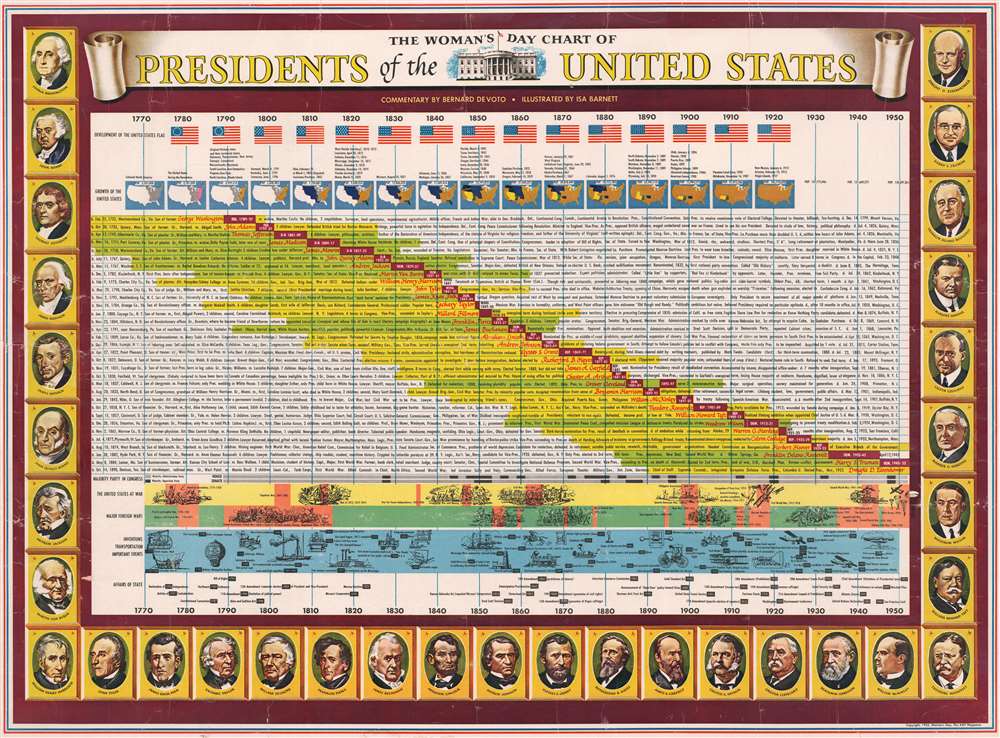Digital Image: 1952 DeVoto and Barnett Pictorial Chart of the Presidents of the United States
Presidents-devotobarnett-1952_d
Title
1952 (dated) 21.5 x 33.5 in (54.61 x 85.09 cm)
Description
FOR THE ORIGINAL ANTIQUE MAP, WITH HISTORICAL ANALYSIS, CLICK HERE.
Digital Map Information
Geographicus maintains an archive of high-resolution rare map scans. We scan our maps at 300 DPI or higher, with newer images being 600 DPI, (either TIFF or JPEG, depending on when the scan was done) which is most cases in suitable for enlargement and printing.
Delivery
Once you purchase our digital scan service, you will receive a download link via email - usually within seconds. Digital orders are delivered as ZIP files, an industry standard file compression protocol that any computer should be able to unpack. Some of our files are very large, and can take some time to download. Most files are saved into your computer's 'Downloads' folder. All delivery is electronic. No physical product is shipped.
Credit and Scope of Use
You can use your digial image any way you want! Our digital images are unrestricted by copyright and can be used, modified, and published freely. The textual description that accompanies the original antique map is not included in the sale of digital images and remains protected by copyright. That said, we put significant care and effort into scanning and editing these maps, and we’d appreciate a credit when possible. Should you wish to credit us, please use the following credit line:
Courtesy of Geographicus Rare Antique Maps (https://www.geographicus.com).
How Large Can I Print?
In general, at 300 DPI, you should at least be able to double the size of the actual image, more so with our 600 DPI images. So, if the original was 10 x 12 inches, you can print at 20 x 24 inches, without quality loss. If your display requirements can accommodate some loss in image quality, you can make it even larger. That being said, no quality of scan will allow you to blow up at 10 x 12 inch map to wall size without significant quality loss. For more information, it is best consult a printer or reprographics specialist.
Refunds
If the high resolution image you ordered is unavailable, we will fully refund your purchase. Otherwise, digital images scans are a service, not a tangible product, and cannot be returned or refunded once the download link is used.
Cartographer S
Bernard Augustine DeVoto (January 11, 1897 - November 13, 1955) was an American historian, columnist, editor, teacher, reviewer, and essayist. He also worked as a speechwriter for Adlai Stevenson. Born in Ogden, Utah, to a Catholic father and a Mormon mother, DeVoto attended the University of Utah for a year before transferring to Harvard University. He served in the U.S. Army during World War I. He returned to Harvard after the war and graduated in 1920. He found a job as an English instructor at Northwestern University in 1922 and remained at Northwestern until he resigned in 1927. While teaching at Northwestern, he published articles and novels under pseudonyms. After resigning, he and his wife Avis moved to Massachusetts, where DeVoto tried to make a living writing and teaching at Harvard part-time. Unfortunately, he never managed to achieve his goal of a permanent full-time teaching position at Harvard. DeVoto began writing articles for Harper's Weekly, which eventually turned into writing the regular column 'The Easy Chair', which ran from 1935 until his death. He received the Pulitzer Prize for History for Across the Wide Missouri in 1947. More by this mapmaker...
Isa Barnett (December 31, 1922 - March 4, 2001) was an American artist, illustrator, and teacher. Born in Carbondale, Pennsylvania, Barnett grew up in Philadelphia and graduated from Northeast High School in 1940. After graduation he attended the Fleisher Art School and the Philadelphia Museum School of Art before being drafted into the U.S. Army to fight in World War II. He served in the 82nd and 101st Airborne Divisions in Europe and then returned to school after the war. Later, he worked as a free-lance artist while teaching at the Philadelphia Museum School and the Moore College of Art. He visited New Mexico for the first time in 1951 and fell in love with the region. From then on, he split his time between Pennsylvania and New Mexico. Over the course of his career, Barnett produced work in numerous kinds of media, including acrylic, charcoal, oil, pen and ink, watercolor, bronze, marble, and lithography. His works appeared in National Geographic, Life, Reader's Digest, the Saturday Evening Post, and more. He submitted a series of twelve painting of the life of Abraham Lincoln to the 1964 New York World's Fair. These paintings are now part of the collection at the Gettysburg Museum. He also produced work for the Franklin Mint, including several large series of medals. He married his wife Annette Edelson Barnett in 1946 with whom he had three children. Learn More...

